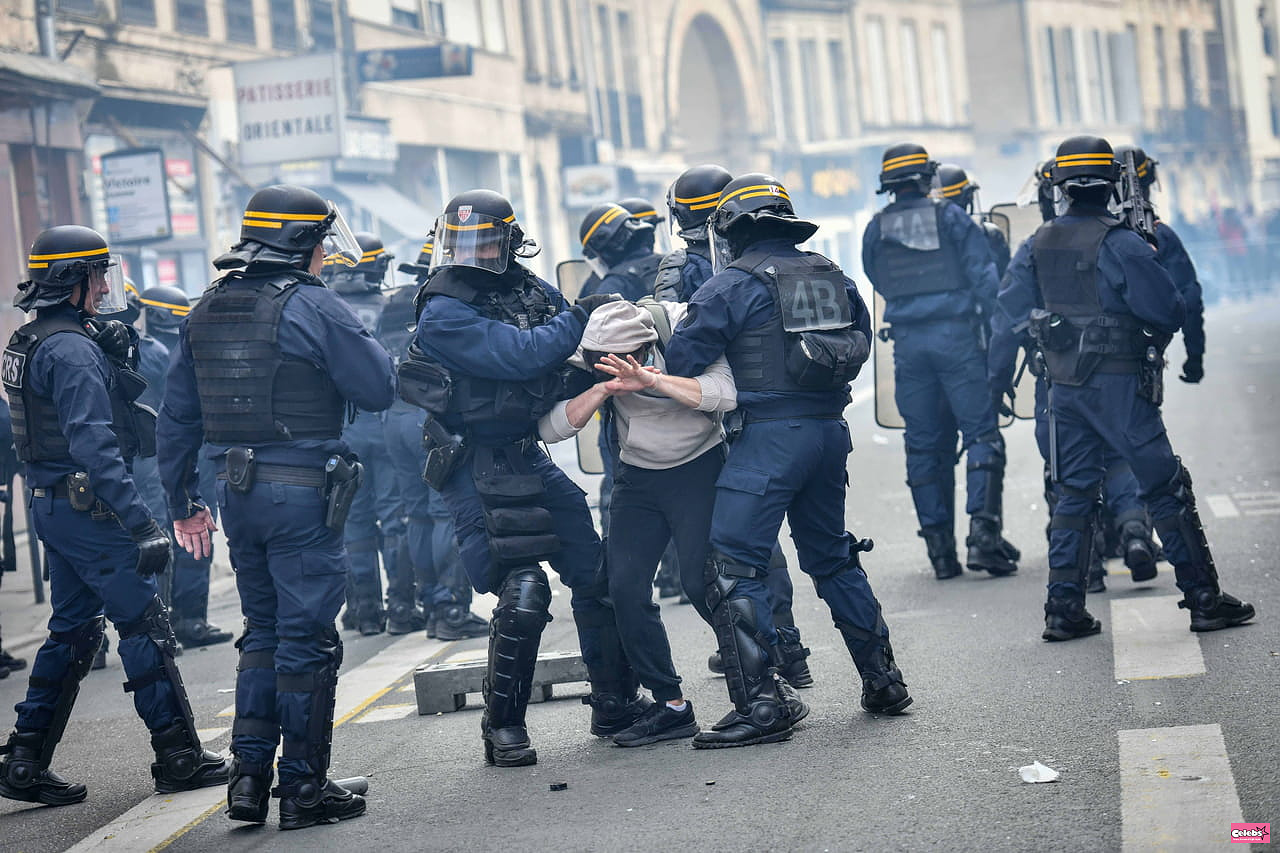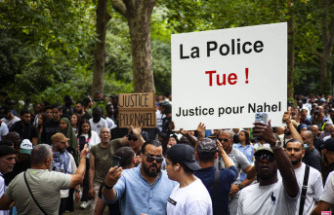POLICE VIOLENCE. Accused of violence, the police have indeed carried out brutal interventions against demonstrators against the pension reform. What are the rules and duties for law enforcement? How are their interventions framed?
Demonstrations parasitized by violence. The unfortunate spectacle can be seen in the streets of many French cities during each protest movement. If this violence seemed to be the preserve of spontaneous rallies against the pension reform - organized daily since the use of 49.3 - they won the union demonstrations during the strike of March 23. In Paris, Rouen, Lyon or even Bordeaux, the clashes sent shivers down your spine.
While incidents routinely pit radical individuals or Black Block thugs against law enforcement, some scenes have drawn particular attention. The sometimes strong interventions of the authorities are considered abusive and arbitrary by elected politicians, mainly from Nupes, who rely on the numerous arrests recorded during the demonstrations. But the Minister of the Interior, Gérald Darmanin, assured him on CNews: "I will not let the police and the gendarmes dirty."
It's recurrent at almost every demonstration: the most extreme violence takes place after dark, once the union procession is over. But why does the situation escalate every time at this time when no significant violence was seen during the mobilizations against the pension reform?
In France, events must be declared in advance to the prefecture: a route and times are thus defined between the organizers and the public authorities. Any gathering outside this framework can thus be considered as a gathering. This situation is defined by article 431-3 of the Penal Code: "Constitutes a crowd any gathering of people on the public highway or in a public place likely to disturb public order." Within this framework, a dispersion can then be carried out, after three summations in very precise terms.
However, the law does not regulate the methods to be used. However, it authorizes the direct use of force, without warning, "if violence or assault is exercised against them or if they cannot otherwise defend the ground they occupy." The police therefore have the task of dispersing the demonstrators once the procession has arrived. But when does a demonstration become a mob? Here is all the question. Only the existence of a risk of disturbing public order differentiates the two situations. Very subjective, so...
During the demonstrations, with the first violence, often come the charges of the police. As one man, police and gendarmes run shield in hand towards the troublemakers. The authorities' primary objective is to keep the crowd and the thugs away from the demonstrators, but the instruction changes in the event of public order disturbances: it is then necessary to "disperse the crowd" after the pronunciation of the summons, as stipulated the national policing scheme. In total, three summonses must be made before any initiatives by the police, including charges. They must be supplemented by a fourth in the event of the use of weapons, such as tear gas and grenades.
In theory, without a warning -which, to be heard, can be associated with a red rocket fire-, no intervention should take place according to the national law enforcement plan. Problem, the summonses have not always been heard before the police charges during the demonstrations against the pension reform.
And even announced, can a police charge target everyone? The charge which aims to disperse a crowd does not seem reserved for a single type of individual, but it seems obvious that it must be carried out against disruptive elements more than classic processions. Images of police rushing towards the heads of the procession are however broadcast. Scenarios can explain such an intervention: thugs who find refuge at the front of a procession, a procession head itself disturbing public order. Otherwise, a charge against a motorcade seems difficult to justify.
This is what is used most by law enforcement when things get out of hand at the end of protests. Tear gas, the stinging white smoke that spreads in the street, is commonplace when situations escalate. It must be said that its "use by a police officer is similar to the use of force", explained the Human Rights League, citing an instruction from the General Directorate of the National Police (DPGN) dated June 14, 2004 So, in this case, tear gas, either in its aerosol form (the hand sprays) or in its grenade form, is used to disperse.
If the current law enforcement scheme does not regulate its use, this same instruction from the DGPN has several elements to take into account: "The bomb must be used by favoring short jets of about one second; The number of jets should be as limited as possible; The bomb should as far as possible not be activated at a distance of less than one meter from a person. Moreover, as with any use of a weapon, their use must be made only "in case of absolute necessity and in a strictly proportionate manner."
However, several videos and testimonies collected during or after the demonstrations point to the abusive use of tear gas, such as in Paris on March 23, where harmless teenagers on a bus shelter were gassed; in Prades, that same day, in the middle of a demonstration in the presence of children because of the attempt to block a road, without violence, by demonstrators (details on France 3 Occitanie); or even in Strasbourg, on March 21, in a trap without exit according to people present on the spot.
On the other hand, the use of tear gas was, in various situations, justified, in particular in Rennes, on March 23, where violent people within a procession threw several projectiles on the police forces present opposite to them. In response, tear gas was sent, given the dangerousness of the situation. Similar context two days earlier in Paris, Place de la République, where law enforcement provocations took place with fireworks mortar fire, to which a response was made by sending tear gas.
It is the weapon available to police and gendarmes that is the most debated in France. The LBD, for defense ball launchers, was particularly criticized during the demonstrations of the yellow vests, during which many participants were injured by its use. Still allowed, its use is once again blamed. The Ministry of the Interior explains, in a response to a question posed to the Senate in 2019, that "the use of the defense ball launcher (LBD) is essential during urban riots, during which individuals attack the forces of order and that it is necessary to isolate and stop the perpetrators of these attacks" and authorizes its use "in the event of self-defense, a state of necessity and the dissipation of a crowd." Thus, it is authorized only within the framework of the assembly and not of the declared demonstration.
Classified as a "weapon falling within war material" (A2), its handling must however be done in strict compliance with the legal framework, set by a joint instruction from the Director General of the National Police and the Director General of the National Gendarmerie of the 27 July 2017. First of all, its use is not subject to prior authorization from a superior "but in immediate reaction to a situation". Above all, its action "can only be legitimate if it is strictly necessary and proportionate to the threat to which it responds." In addition, the police and gendarmes who use it must only target the torso, lower and upper limbs. Headshots are strictly prohibited.
In Paris, on March 20, a police officer used his LBD against a person when no threat, at the time T, seemed to endanger the physical integrity of the agent. However, the extract of only nine seconds does not make it possible to know what really happened beforehand. Moreover, the plan being fixed on the shooter, nothing says that the targeted person was hit.
In Montpellier, a threat by LBD was brandished against journalists. Despite their particularly audible cries to signal that they were from the press, two men were aimed at face level by a policeman with this weapon. A video of the same moment filmed by a local resident, from his window, also shows that the duo did not present a threat to the safety of the police.
Among the police interventions pointed out, beyond their weapons, are the "traps", also called "encirclement". This police technique, which consists of surrounding a group of people in a mobile or immobile manner with a cordon formed by members of the police, has a specific goal: "to prevent or put an end to serious and imminent violence against people and property" or "monitoring" and "challenging" individuals. Demonstrators and politicians denounce these interventions recalling that they have been prohibited since a decision rendered by the Council of State in June 2021.
The legal institution has requested the withdrawal of the trap technique from the national law enforcement scheme, judging that "there is no guarantee that its use is appropriate, necessary and proportionate to the circumstances". And the Council of State added that the trap is also "likely to significantly affect the freedom to demonstrate and to undermine the freedom to come and go".
But the ban on the use of traps is not total. Since its revision in 2021, the national law enforcement plan provides that a trap must "systematically provide a controlled exit point" for people surrounded - which was not respected in Strasbourg (see the video more above) and should not be maintained beyond a "strictly necessary and proportionate period". A nuance recalled by Laurent Nunez, prefect of police of Paris at the microphone of BMFTV. Still, no time limit is clearly established for a trap, except that the encirclement must be lifted at the end of the demonstration or gathering.
The encirclement poses several problems, starting with the lack of distinction between the individuals detained, whether they are hostile, pacifists, demonstrators or simple passers-by. It also regularly happens that people from outside the controlled crowd are held in the trap.
Accusations of police violence have multiplied since the start of spontaneous demonstrations, especially on the left of the political spectrum. In fact, 11 investigations were entrusted to the IGPN, two of which were safe for suspicion of police violence. On this subject, Gérald Darmanin declared: "It may be that, individually, the police and the gendarmes, often under the influence of fatigue, commit acts which are not in conformity with what they have been taught at the training and ethics" then calling for "sanctioning them". The first, opened on Tuesday, concerns the video showing a member of the Motorized Violent Action Repression Brigade (Brav-M) kicking a man who is falling stiff. According to elements of BFMTV, the demonstrator struck was in the process of opposing a window breaker. Police for their part described a "drunk" man who staggered when he was "pushed violently" before being seen demonstrating later in the evening.
The second investigation was opened for violence committed by a person holding public authority after the complaint of a young woman who was beaten with a truncheon by a Brav-M agent in the Châtelet sector, while she did not appear to be committing any wrongdoing.
If other complaints have been filed, they have not yet given rise to investigations by the IGPN. The Defender of Rights who recalled the code of ethics of the police in the face of preventive measures and arrests, however, invited people confronted with police violence to contact her service.
Since the activation of Article 49.3 of the Constitution to force through the pension reform, the demonstrations - declared or not - have taken a more violent turn. This was not without consequence since many injuries, everywhere in France, are to be deplored. On the side of the demonstrators, a woman in particular saw her thumb being torn off during a demonstration in Rouen on March 23. On the side of the police, many injuries were recorded: 411 for Thursday alone according to the Minister of the Interior, Gérald Darmanin. Among them, a police officer knocked out by a cobblestone in Paris, another in Toulon received… a Linky meter on the head (!) or a third was injured in the hand in Poitiers.
It must be said that if the rallies and demonstrations were originally to say no to the pension reform, the most radical elements seem simply present to shout their hostility or even their hatred against the police. , using various means to provoke. Slogans far from those chanted by opponents of the bill.
With Cecile Vassas


![Loto result (FDJ): the draw for Saturday May 4, 2024 [LIVE]](https://www.celebsnet.com/images/resize/95/334x215/haberler/thumbs/2024/05/_3041a.png)








